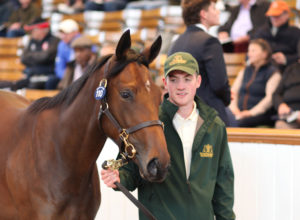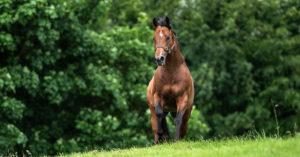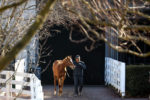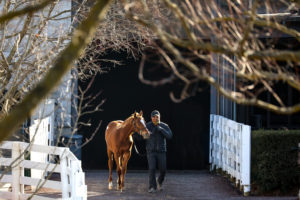There is no doubt that yearling vendors are happier after the latest round of sales. The big five yearling auctions – Arqana August, Goffs Orby, Goffs UK Premier, plus Tattersalls Books 1 and 2 – all comfortably outscored their 2020 positions, when it came to aggregate, average price and clearance rates. All five sales combined produced an average price of £112,329, which was 8% up on the 2020 average of £103,842, albeit still shy of 2019’s pre-Covid average of £121,278, a gap of 7.4%.
But other things were afoot too. The failure to match the 2019 average price was caused by weaker than usual demand for the top yearlings. Arqana and Tattersalls October Books 1 and 2 sales failed to better the average posted last year and in 2019, by the top 10% segment of their offerings.
The top 37 yearlings at Book 1 averaged £748,000, down from £994,000 last year and from £1,022,000 in 2019. This was a trend also seen earlier at the Keeneland September Sale, where buyers were reluctant to go overboard and often formed partnerships that curtailed excessive selling prices. But, as they say, every cloud has a silver lining, and in the case of European yearling sales that took the form of money spilling down through the sales and making a lot of middle- and lower-tier vendors very happy indeed. Tattersalls Book 2, 3 and 4 sellers were the beneficiaries as buyers sought to fill orders.
Book 2’s top 10% segment just failed to set a record average, but the remaining nine 10% segments outsold everything that came before at this sale and the average got better the further down the market you went, even when compared to pre-Covid prices. The gains were of the order of +7%, +5%, +3%, +12%, +12%, +16%, +19%, +22% and +41%.
That trend had begun in Book 1, where the bottom 60% of the market had also eclipsed anything that had gone before. Conversely, neither of the two sales held in August – Arqana and Goffs UK Premier – managed to improve on their 2019 figures, but when Goffs Orby rolled around buyers started to get serious and drove the bottom half of that market to levels beyond those recorded in 2019.

A No Nay Never filly provided one of the scores of the year, rising in value from €265,000 as a foal to 825,000gns as a yearling for Philipp Stauffenberg | Photo: Tattersalls
In essence, the £233 million spent at these five sales may have been down £23m on 2019 but it was more equitably distributed, benefitting many more sellers.
As we can deduce from this year’s figures, the yearling sales have bounced back with a vengeance. Even without the buying power of Shadwell Estates, there has been a strong demand that has cascaded down the ranks. Predictably, stallion averages and medians have also benefitted, particularly for mid-ranking stallions, many of whom had more six-figure yearlings than normal.
“The average listed nomination cost for all mares visiting a top-30 sire in 2011 was only £44,000, compared to the £81,000 for the class of 2019”
Using our basket of five main sales to analyse how stallions fared compared to both 2020 and, more importantly, 2019, the results are indeed encouraging. But before we take you down this road, it may be worthwhile looking at the market for nominations relating to the current crop of yearlings.
Ten years ago, the 30th most expensive stallion in Britain and Ireland had an advertised fee of just €15,000. By 2019, the 30th most expensive stallion stood at €30,000. What’s more, the average listed nomination cost for all mares visiting a top-30 sire in 2011 was only £44,000, compared to the £81,000 for the class of 2019.
Even more startling is the fact that there were only 3,624 mares covered in 2011 by the top 30 stallions, compared to 4,202 in 2019. So, we can see that investment in nominations in the 30 most sought-after stallions has actually doubled between 2011 and 2019, from about £100 million to £218 million, allowing for barren mares and fee discounts. That’s an increase of 118% and is way more than the increase in average yearling price at the related five main yearling sales, which rose from £84,000 in 2013 to £112,000 this year, a jump of just 33%.

Mehmas: 85% of his yearlings have made money for their vendors this year
Ordinarily we would be over the moon that the yearling market grows as consistently as it does, Covid year notwithstanding, but given the surge in nomination investment it is easy to understand the relentless pressure increasing stud fees place upon profitability. Despite the 33% increase in average price at the five main sales since 2013, the profitability score of 64% – those making more than their conception fee, plus £20,000 upkeep – has not increased.
“No fewer than 66% of pinhooked yearlings made money for their sellers after a £10,000 fee is added to their foal price”
Bringing the comparison up to date, the 64% of profitable yearlings at the big five sales this year comfortably exceeded the 58% of last year, but is marginally behind the 65% recorded in 2019, before the effects of Covid intervened. So, it seems, we need consistent growth in the yearling market just to maintain any prospect of preserving profit margins.
Not all yearlings are sold by their breeders, so stallion profitability figures are in some instances notional, but nonetheless still very useful. Not so our foal-to-yearling analysis as this deals in cold hard facts. Again using our top five yearling sales, we note that traders enjoyed much better market conditions than they did last year. No fewer than 66% of pinhooked yearlings made money for their sellers after a £10,000 fee is added to their foal price. That compares to 58% in 2020, a year when there was a reduced number of foals offered as yearlings at the big five sales.
But again there were structural differences this time around in that there were fewer jackpot yearlings. Only ten yearlings at the big five sales sold for a price £200,000 or more than their foal price. There were 13 last year and 22 in 2019. The 54 yearlings clearing £100,000 profit recovered from 42 a year ago, but is still marginally down from 55 in 2019. Incidentally, fewer yearlings (63%) turned a profit in 2019, so once again more traders made money this time around, but fewer hit the jackpot. Given the strong demand for yearlings this year, we can expect pinhookers to be well armed come the foal sales later this year. It is quite possible, however, that we will see some aversion to paying high prices.
Among the big winners from the ranks of individual stallions were Dubawi, who posted the best average of any sire, something he does regularly. Unsurprisingly, Mehmas, working off a low fee and after a fantastic year on the racecourse, saw 85% of his yearlings making money after £20,000 upkeep has been applied – again the best in the business by this criteria. He was also high on the leaderboard by how much his yearling average eclipsed his fee (9.5 times), but he couldn’t quite match Darley’s Farhh, whose average price of £109,623 was 10.5 times his 2019 fee.
All told 58 stallions managed to post an average of at least three times their fee. Saxon Warrior and Roaring Lion, rivals on the track, rejoined their battle at the sales and were the two most sought after first-season sires, while Cracksman and Harry Angel did particularly well with their first yearlings.



